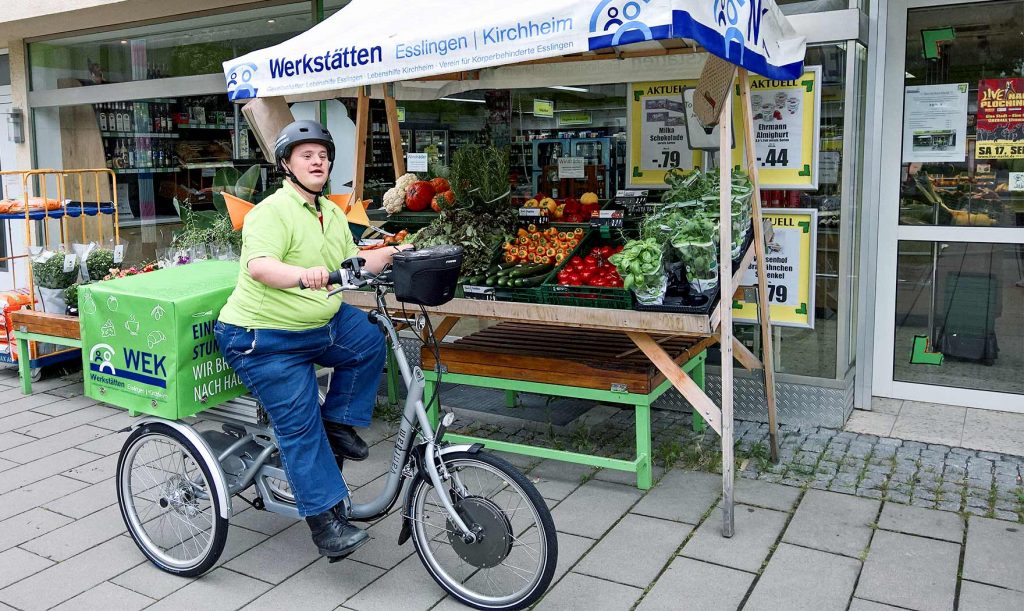
The employees of the WEK Werkstätten Esslingen transport goods for the inclusive grocery store "Um’s Eck" and the Café Morlock. Older people in particular, for whom the shopping is too heavy, are happy to take advantage of this offer. So that the goods are not only transported “around the corner”, the radius is now to be expanded. While the couriers are currently on foot and with a cargo bike, more cargo e-bikes are to be purchased in the future and sStreetscooter will also be used for transport.
The WEK workshops would like to enlarge the delivery area, the delivery orders and the range of delivered products, optimize the capacity utilization and qualify even more employees with disabilities for the primary labor market. Not only do the delivery men benefit from the project, but also the employees in the workshops and in picking.
Create conditions for participation in road traffic
Unfamiliar routes, inclines, heavy traffic and orientation can cause difficulties for people with disabilities. These must therefore be analyzed in advance. Due to the specific requirements of disabled employees in terms of roadworthiness and safety, technical support is required: both in the form of a digital assistance system for route planning (taking into account the deployment restrictions for severely disabled delivery drivers) and during the tours, e.g. B. through telematics systems, navigation and emergency communication options with the group leader. When planning tours, gts comes into play. The InkluServ research project has now emerged from the original WEK business model.
Ambitious and exciting inclusion project
InkluServ is a sub-project of the program "Design of digitally supported interaction work for severely disabled delivery drivers". The project is funded by the Federal Ministry of Education and Research and the European Social Fund of the European Union. The project partners of the three-year research project are the WEK Werkstätten Esslingen, the Fraunhofer Institute for Industrial Engineering and Organization (IAO) and gts. Based on its experience with customers from the social economy, gts was brought on board to develop software for route planning and navigation.
The task for gts is to develop barrier-free route planning and navigation for the couriers and delivery drivers and to program the integrated surface that takes into account the specific requirements of disabled people and the need for support. Due to its expertise in the field of service research and development, Fraunhofer IAO is responsible for analyzing the requirements of interactive work on those involved in the delivery process, for developing measures for qualification and job design, and for the accompanying evaluation.
Objectives of the InkluServ project
The primary aim of the project is to enable people with severe disabilities for the first job market, i.e. to work under real competitive conditions. With the help of the digital assistance system, severely disabled employees are to be enabled to independently interact with customers outside the immediate support areas of the workshops. Through personal customer contact, employees experience appreciation and recognition as an independently acting personality. By means of qualification, interaction work and skills-supporting assistance systems, barriers to inclusion that arise due to skill restrictions are to be reduced.

New challenge for gts
The software that gts will develop comprises the route planning and navigation modules as well as the interfaces to the merchandise management system and web shop. First, the requirements of the couriers and delivery drivers are analyzed and the need for support is identified. These criteria are incorporated into the development of the digital assistance system, e.g. by reducing the functionality and simplifying the operating concept. The challenge also lies in preparing employees for new work steps, new customers and new, sometimes unpredictable, requirement situations. In order to deliver the promised goods on time and to ensure professional delivery of the goods, employees must be trained and qualified.
Tour planning is new for gts, in which people with disabilities actively access information from tour planning and navigation. This means a special quality of requirements for the proven software systems, because up to now gts has been active in the area of route planning for the transport of people with disabilities.
Route planning and navigation with special criteria
The route planning software will assign the individual requirements, such as B. Orientation ability, physical condition, mental resilience, recovery times, experience with routes, customers and tours, enable. The software then calculates individual route suggestions based on these specific criteria. This includes, for example, taking into account uphill and downhill gradients or blocking paths with potentially excessive demands.
The navigation module will include the connection of map material (e.g. OpenStreetMap) and the adaptation of the navigation to the requirements of the severely disabled delivery driver (e.g. exclusion of roads / paths that require complex orientation, steep inclines / descents, heavily traveled streets). The digital assistance system is used via mobile tablets. During development, it is also important to consider a barrier-free user interface in simple language and with a clear representation (colors, sizes, contrasts).
Outlook
In the long term, gts would like to place an offer for inclusive service companies on the basis of the know-how gain and also set new priorities in the field of bicycle navigation. In view of the mobility discussion, the developers at gts want to research alternative distribution systems with bicycle use for people with and without disabilities.

The InkluServ project is funded by the Federal Ministry of Education and Research and the European Social Fund of the European Union as part of the “Design of digitally supported interaction work for severely disabled delivery drivers” program. (Funding code 02L18A222)




